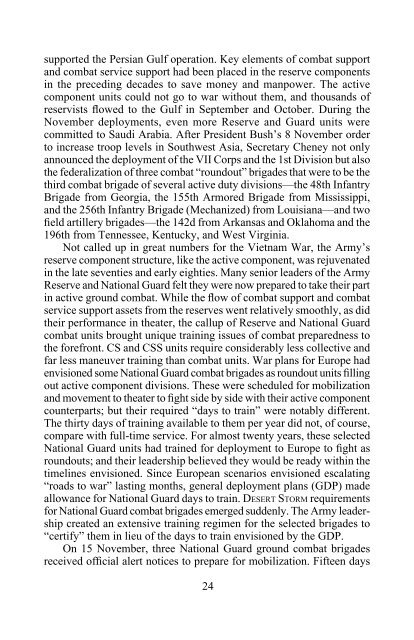You also want an ePaper? Increase the reach of your titles
YUMPU automatically turns print PDFs into web optimized ePapers that Google loves.
supported the Persian Gulf operation. Key elements of combat supportand combat service support had been placed in the reserve componentsin the preceding decades to save money and manpower. The activecomponent units could not go to war without them, and thousands ofreservists flowed to the Gulf in September and October. During theNovember deployments, even more Reserve and Guard units werecommitted to Saudi Arabia. After President Bush’s 8 November orderto increase troop levels in Southwest Asia, Secretary Cheney not onlyannounced the deployment of the VII Corps and the 1st Division but alsothe federalization of three combat “roundout” brigades that were to be thethird combat brigade of several active duty divisions—the 48th InfantryBrigade from Georgia, the 155th Armored Brigade from Mississippi,and the 256th Infantry Brigade (Mechanized) from Louisiana—and twofield artillery brigades—the 142d from Arkansas and Oklahoma and the196th from Tennessee, Kentucky, and West Virginia.Not called up in great numbers for the Vietnam War, the Army’sreserve component structure, like the active component, was rejuvenatedin the late seventies and early eighties. Many senior leaders of the ArmyReserve and National Guard felt they were now prepared to take their partin active ground combat. While the flow of combat support and combatservice support assets from the reserves went relatively smoothly, as didtheir performance in theater, the callup of Reserve and National Guardcombat units brought unique training issues of combat preparedness tothe forefront. CS and CSS units require considerably less collective andfar less maneuver training than combat units. War plans for Europe hadenvisioned some National Guard combat brigades as roundout units fillingout active component divisions. These were scheduled for mobilizationand movement to theater to fight side by side with their active componentcounterparts; but their required “days to train” were notably different.The thirty days of training available to them per year did not, of course,compare with full-time service. For almost twenty years, these selectedNational Guard units had trained for deployment to Europe to fight asroundouts; and their leadership believed they would be ready within thetimelines envisioned. Since European scenarios envisioned escalating“roads to war” lasting months, general deployment plans (GDP) madeallowance for National Guard days to train. Desert Storm requirementsfor National Guard combat brigades emerged suddenly. The Army leadershipcreated an extensive training regimen for the selected brigades to“certify” them in lieu of the days to train envisioned by the GDP.On 15 November, three National Guard ground combat brigadesreceived official alert notices to prepare for mobilization. Fifteen days24












